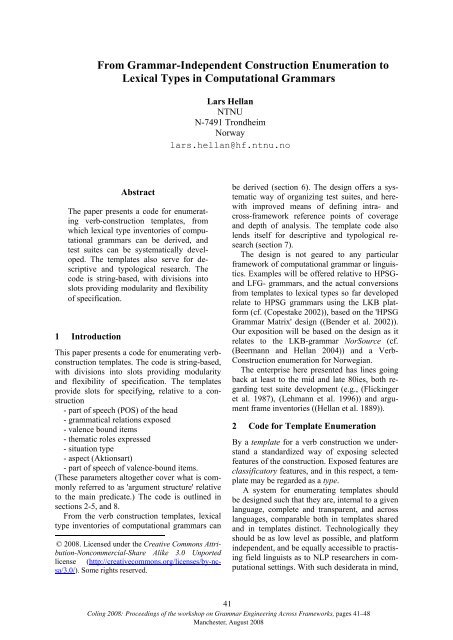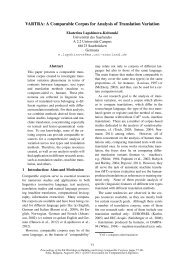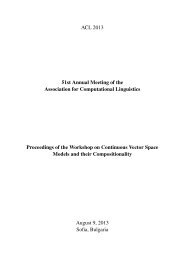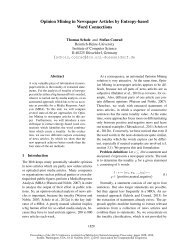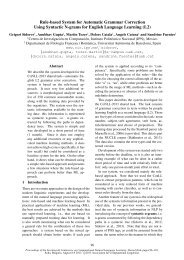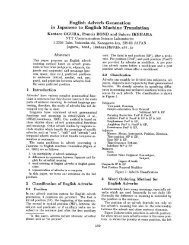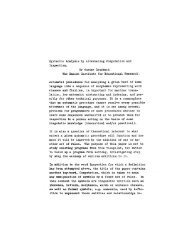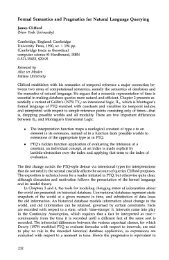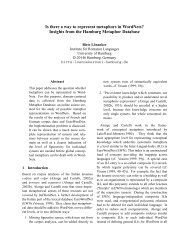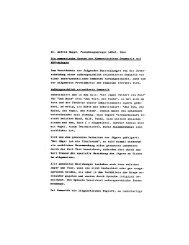From Grammar-Independent Construction Enumeration to Lexical ...
From Grammar-Independent Construction Enumeration to Lexical ...
From Grammar-Independent Construction Enumeration to Lexical ...
You also want an ePaper? Increase the reach of your titles
YUMPU automatically turns print PDFs into web optimized ePapers that Google loves.
<strong>From</strong> <strong>Grammar</strong>-<strong>Independent</strong> <strong>Construction</strong> <strong>Enumeration</strong> <strong>to</strong><br />
<strong>Lexical</strong> Types in Computational <strong>Grammar</strong>s<br />
Abstract<br />
The paper presents a code for enumerating<br />
verb-construction templates, from<br />
which lexical type inven<strong>to</strong>ries of computational<br />
grammars can be derived, and<br />
test suites can be systematically developed.<br />
The templates also serve for descriptive<br />
and typological research. The<br />
code is string-based, with divisions in<strong>to</strong><br />
slots providing modularity and flexibility<br />
of specification.<br />
1 Introduction<br />
This paper presents a code for enumerating verbconstruction<br />
templates. The code is string-based,<br />
with divisions in<strong>to</strong> slots providing modularity<br />
and flexibility of specification. The templates<br />
provide slots for specifying, relative <strong>to</strong> a construction<br />
- part of speech (POS) of the head<br />
- grammatical relations exposed<br />
- valence bound items<br />
- thematic roles expressed<br />
- situation type<br />
- aspect (Aktionsart)<br />
- part of speech of valence-bound items.<br />
(These parameters al<strong>to</strong>gether cover what is commonly<br />
referred <strong>to</strong> as 'argument structure' relative<br />
<strong>to</strong> the main predicate.) The code is outlined in<br />
sections 2-5, and 8.<br />
<strong>From</strong> the verb construction templates, lexical<br />
type inven<strong>to</strong>ries of computational grammars can<br />
© 2008. Licensed under the Creative Commons Attribution-Noncommercial-Share<br />
Alike 3.0 Unported<br />
license (http://creativecommons.org/licenses/by-ncsa/3.0/).<br />
Some rights reserved.<br />
Lars Hellan<br />
NTNU<br />
N-7491 Trondheim<br />
Norway<br />
lars.hellan@hf.ntnu.no<br />
be derived (section 6). The design offers a systematic<br />
way of organizing test suites, and herewith<br />
improved means of defining intra- and<br />
cross-framework reference points of coverage<br />
and depth of analysis. The template code also<br />
lends itself for descriptive and typological research<br />
(section 7).<br />
The design is not geared <strong>to</strong> any particular<br />
framework of computational grammar or linguistics.<br />
Examples will be offered relative <strong>to</strong> HPSG-<br />
and LFG- grammars, and the actual conversions<br />
from templates <strong>to</strong> lexical types so far developed<br />
relate <strong>to</strong> HPSG grammars using the LKB platform<br />
(cf. (Copestake 2002)), based on the 'HPSG<br />
<strong>Grammar</strong> Matrix' design ((Bender et al. 2002)).<br />
Our exposition will be based on the design as it<br />
relates <strong>to</strong> the LKB-grammar NorSource (cf.<br />
(Beermann and Hellan 2004)) and a Verb-<br />
<strong>Construction</strong> enumeration for Norwegian.<br />
The enterprise here presented has lines going<br />
back at least <strong>to</strong> the mid and late 80ies, both regarding<br />
test suite development (e.g., (Flickinger<br />
et al. 1987), (Lehmann et al. 1996)) and argument<br />
frame inven<strong>to</strong>ries ((Hellan et al. 1889)).<br />
2 Code for Template <strong>Enumeration</strong><br />
By a template for a verb construction we understand<br />
a standardized way of exposing selected<br />
features of the construction. Exposed features are<br />
classifica<strong>to</strong>ry features, and in this respect, a template<br />
may be regarded as a type.<br />
A system for enumerating templates should<br />
be designed such that they are, internal <strong>to</strong> a given<br />
language, complete and transparent, and across<br />
languages, comparable both in templates shared<br />
and in templates distinct. Technologically they<br />
should be as low level as possible, and platform<br />
independent, and be equally accessible <strong>to</strong> practising<br />
field linguists as <strong>to</strong> NLP researchers in computational<br />
settings. With such desiderata in mind,<br />
41<br />
Coling 2008: Proceedings of the workshop on <strong>Grammar</strong> Engineering Across Frameworks, pages 41–48<br />
Manchester, August 2008
we develop a code residing simply in strings of<br />
symbols with a minimum of internal syntax.<br />
The basic structural parts of such strings are<br />
referred <strong>to</strong> as slots. In the slot specification, the<br />
following conventions are observed:<br />
* Slots are interconnected by '-' (hyphen).<br />
* Distinct items inside a slot are interconnected<br />
by '_' (underline).<br />
* An item label containing neither ‘-‘ nor ‘_’ is<br />
an uninterrupted string of letters. Internal composition<br />
is indicated by alternation between small<br />
and capital letters.<br />
The format can be applied also <strong>to</strong> non-verbal<br />
constructions, but we here focus exclusively on<br />
verbal ones. These have a template structure with<br />
five slots:<br />
Slot 1: POS of the head, and diathesis information.<br />
Slot 2: Valency, or transitivity specification (e.g.,<br />
intr, tr, ditr,... ).<br />
Slot 3: Dependents' specification (syntactic and<br />
referential properties of arguments).<br />
Slot 4: Participant roles.<br />
Slot 5: Situation type (written in SMALL CAPS).<br />
Slots 1 and 2 are always filled, the others need<br />
not be. A slot not specified is not displayed as<br />
empty; however, the sets of labels defined for the<br />
various slots are disjoint. Likewise, no labels are<br />
distinguished in terms of capital letter vs. not. (1)<br />
illustrates the composition, for a type instantiated<br />
by the clause Mary throws the ball:<br />
(1) v-tr-obDir-suAg_obEjct-EJECTION<br />
Slot 1 here says the head is Verb, slot 2 says that<br />
the construction is transitive, slot 3 says that the<br />
object har a directional function, slot 4 says that<br />
the thematic roles are 'agent', expressed by the<br />
subject, and 'ejected', expressed by the object,<br />
and slot 5 says that the situation type is one characterizable<br />
as 'ejection'.<br />
We start with a survey of the labels used for<br />
slot 2, valence information. First, for the use of<br />
the notions intr, tr, ditr, the following definitions<br />
apply. By a direct syntactic argument of a<br />
verb, we understand a nominal constituent syntactically<br />
related <strong>to</strong> the verb as subject-of, direct<br />
object-of, or indirect object-of, and any clausal<br />
constituent with either of these functions. (This<br />
includes expletive subjects and objects, and excludes<br />
clausal constituents in extraposed position;<br />
it also excludes any NP or clause governed<br />
by a preposition or another relation-item.) An<br />
intransitive construction is then one with only<br />
SUBJECT as a direct syntactic argument, a transi-<br />
42<br />
tive construction has a SUBJECT and one OB-<br />
JECT as direct syntactic arguments, and a ditransitive<br />
construction has a SUBJECT and two OB-<br />
JECTs as direct syntactic arguments. Any valence-bound<br />
item other than those now described<br />
is represented by an extension of the above transitivity-strings,<br />
for instance, in the strings intrObl<br />
and trObl, Obl means 'oblique', that is,<br />
in addition <strong>to</strong> the number of arguments represented<br />
by intr/tr, there is a PP with 'selected'<br />
status.<br />
The valence slot includes information as <strong>to</strong><br />
referential status of the arguments. We say that a<br />
direct syntactic argument is standardly linked<br />
when it has referential content and has a semantic<br />
argument function relative <strong>to</strong> the verb. This<br />
excludes expletive subjects and expletive objects,<br />
as well as 'raised' full NPs. The following substrings<br />
in slot 2 indicate the presence of items<br />
that are not standardly linked:<br />
Impers ('impersonal'), Presentational, Epon<br />
('extraposition'), Nrf ('non-referential'), Rais<br />
('item raised, i.e., non-argument'), Nrg ('nonargument'<br />
- used in slot 3)).<br />
Specifications are sought <strong>to</strong> be non-redundant.<br />
For instance, the string intrEpon occurring in<br />
slot 2 entails that there is an expletive subject,<br />
and when used for a langauge like English, there<br />
is no need <strong>to</strong> say elsewhere that the subject is<br />
expletive. Since what is redundant relative <strong>to</strong> one<br />
language may not be so relative <strong>to</strong> another, questions<br />
of language-parametrized interpretation of<br />
code may arise; however, we do not have a basis<br />
yet for suggesting whether and how this would<br />
be accommodated.<br />
3 Valency labels<br />
The slot for valency, slot 2, has around 45 possible<br />
specifications relevant <strong>to</strong> Norwegian, and we<br />
state those in full, <strong>to</strong> give an impression of what<br />
may be the expected scope of this slot; an example<br />
illustrates each type:<br />
intr = intransitive, i.e., with only SUBJECT as<br />
direct syntactic argument.<br />
intrImpers = impersonal intransitive, i.e.,<br />
SUBJECT is an expletive not linked <strong>to</strong> any other<br />
item in the clause. (Ex.: det regner 'it rains')<br />
intrImpersPrtcl = impersonal intransitive<br />
with an aspectual particle. (Ex.: det klarner opp<br />
'it clears up')<br />
intrImpersObl = impersonal intransitive with<br />
an oblique argument. (Ex.: det synger i fjellene
'it sings in the mountains')<br />
intrPresentational = intransitive with a<br />
presentational structure, i.e., an expletive subject<br />
and an indefinite NP.<br />
intrDirPresentational = intrPresentational<br />
where the presented NP has a directional<br />
function. (Ex.: det springer en mann 'there runs a<br />
man')<br />
intrPresentationalLoc = intrPresentational<br />
with a locative constituent. (Ex.: det sitter<br />
en mann i s<strong>to</strong>len 'there sits a man in the chair')<br />
intrDir = intransitive where the subject has a<br />
directional function. (Ex.: gutten løper 'the boy<br />
runs')<br />
intrAdv = intransitive with an obliga<strong>to</strong>ry adverb.<br />
(Ex.: han fungerer godt 'he functions well')<br />
intrPrtcl = intransitive with an aspectual particle.<br />
(Ex.: regnet varer ved 'the rain lasts')<br />
intrObl = intransitive with an oblique argument.<br />
(Ex.: jeg snakker om Ola 'I talk about Ola')<br />
intrOblRais = intransitive with an oblique<br />
argument from which an NP has been 'raised'.<br />
(Ex.: han later til å komme 'he appears [<strong>to</strong>] <strong>to</strong> come')<br />
intrScpr = intransitive with a secondary predicate<br />
(Small Clause predicate). (Ex.: gutten virker<br />
syk 'the boy seems sick')<br />
intrEpon = intransitive with an 'extraposed'<br />
clause. (Ex.: det hender at han kommer 'it happens<br />
that he comes')<br />
intrPrtclEpon = intransitive with an 'extraposed'<br />
clause and an advparticle. (Ex.: det hører<br />
med at han kommer Mock Eng: "it hears along that<br />
he comes")<br />
intrOblEpon = intransitive with an 'extraposed'<br />
clause and an oblique argument. (Ex.: det haster<br />
med å rydde Mock Eng: "it urges with <strong>to</strong> tiden up")<br />
intrPrtclOblEpon = intransitive with an 'extraposed'<br />
clause, an oblique argument, and an<br />
advparticle. (Ex.: det ser ut til at han kommer Mock<br />
Eng: "it looks out <strong>to</strong> that he comes")<br />
intrPrtclOblRais = intransitive with an<br />
oblique argument from which an NP has been<br />
'raised', and an advparticle. (Ex.: han ser ut til å<br />
komme Mock Eng: "he looks out <strong>to</strong> <strong>to</strong> come")<br />
intrImplicobjObl = intransitive with implicit<br />
object, followed by PP (Ex.: han sølte på seg 'he<br />
spilled on himself')<br />
tr = transitive, i.e., with SUBJECT and one OB-<br />
JECT.<br />
trDir = transitive, where the subject is unders<strong>to</strong>od<br />
in a directional function. (Ex.: Kari når <strong>to</strong>ppen<br />
'Kari reaches the <strong>to</strong>p')<br />
trPrtcl = transitive with an advparticle. (Ex.:<br />
Kari fant ut svaret 'Kari found out the answer')<br />
43<br />
trPresentational = presentational structure<br />
with an NP preceding the 'presented' NP. (Ex.: det<br />
venter ham en ulykke 'there awaits him an accident')<br />
trObl = transitive with an oblique. (Ex.: jeg<br />
sparker Ola i baken 'I kick Ola in the butt')<br />
trEponSu = transitive with an extraposed clause<br />
correlated with the subject, and an argument object.<br />
(Ex.: det bekymrer meg at han kommer 'it worries<br />
me that he comes')<br />
trEponOb = transitive with an extraposed clause<br />
correlated with the object, and an argument subject..<br />
(Ex.: vi muliggjorde det at han fikk innreisetillatelse<br />
'we possible-made it that he got entrance visa')<br />
trScpr = transitive with a secondary predicate<br />
(Small Clause predicate). (Ex.: han sparket ballen<br />
flat 'he kicked the ball flat')<br />
trNrf = transitive whose object is nonreferential.<br />
(Ex.: Kari skammer seg "Kari shamess<br />
herself" - 'Kari is ashamed')<br />
ditr = ditransitive, i.e., with SUBJECT and two<br />
OBJECTs (here referred <strong>to</strong> by the traditional<br />
terms 'indirect' ('iob') and 'direct' object, when<br />
distinction is necessary).<br />
ditrObl = ditransitive with oblique. (Ex.: jeg<br />
kaster Ola kakestykker i ansiktet "I throw Ola cakes<br />
in the face" - 'I throw cakes in the face of Ola')<br />
ditrNrf = ditransitive whose indirect object is<br />
non-referential. (Ex.: han foresetter seg å komme<br />
'he [foresetter] himself <strong>to</strong> come)<br />
copAdj = predicative copular construction with<br />
adjectival predicative. (Ex.: han er snill 'he is<br />
kind'). (Similarly: copN. (Ex.: han er bonde 'he is<br />
peasant'); copPP (Ex.: forestillingen var under<br />
enhver kritikk 'the perforrmance was below critique');<br />
copPredprtcl (Ex.: Ola er som en gud 'Ola is<br />
like a god'))<br />
copIdN = identity copular construction with<br />
nominal predicative. (Ex.: dette er mannen 'this is<br />
the man'.) (Similarly: copIdAbsinf (Ex.:<br />
oppgaven er å spise silden 'the task is <strong>to</strong> eat the herring'.);<br />
copIdDECL (Ex.: problemet er at han spiser<br />
silden 'the problem is that he eats the herring'.);<br />
copIdYN (Ex.: problemet er om han spiser silden<br />
'the problem is whether he eats the herring'.);<br />
copIdWH (Ex.: spørsmålet er hvem som spiser silden<br />
'the question is who eats the herring'.))<br />
copEponAdj = predicative copular construction<br />
with adjectival predicative and the 'logical subject'<br />
extraposed. (Ex.: det er uvisst hvem som kommer<br />
'it is uncertain who that comes'.) Similarly: copEponN<br />
(Ex.: det er et spørsmål hvem som kommer<br />
'it is a question who comes'.); copEponPP (Ex.: det<br />
er hinsides diskusjon at han kommer 'it is beyond discussion<br />
that he comes'.); copEponPredprtcl
(Ex.: det var som bestilt at han tapte igjen 'it was like<br />
booked that he lost again'.))<br />
4 Dependents' labels<br />
The slot for dependents, slot 3, has around 40<br />
labels relevant for Norwegian. Each is built up<br />
with a first part indicating the grammatical function<br />
of the item specified (su, ob, iob, obl,<br />
sc, epon), and the remainder providing the<br />
specification, possibly also with some internal<br />
structure. The following lists most of them:<br />
suExpl = subject is an expletive.<br />
suDECL = subject is a declarative clause. (Similarly:<br />
suYN = subject is a yes-no-interrogative<br />
clause; suWH = subject is a wh-interrogative<br />
clause; suAbsinf = subject is an infinitival<br />
clause with non-controlled interpretation.)<br />
suNrg = subject is a non-argument.<br />
obDir = object is unders<strong>to</strong>od in a directional<br />
capacity.<br />
obRefl = object is a reflexive.<br />
obReflExpl = object is an expletive reflexive.<br />
obDECL = object is a declarative clause. (Similarly:<br />
obYN, obWH, obAbsInf)<br />
obEqInf = object is an infinitive equi-controlled<br />
by the only available possible controller.<br />
obEqSuInf = object is an infinitive equicontrolled<br />
by subject.<br />
obEqIobInf = object is an infinitive equicontrolled<br />
by indirect object.<br />
obEqSuBareinf = object is a bare infinitive<br />
equi-controlled by subject.<br />
obEqIobBareinf = object is a bare infinitive<br />
equi-controlled by indirect object.<br />
iobRefl = indirect object is a reflexive.<br />
iobReflExpl = indirect object is an expletive<br />
reflexive.<br />
oblEqSuInf = the governee of the oblique is an<br />
infinitive equi-controlled by subject.<br />
oblEqObInf = the governee of the oblique is an<br />
infinitive equi-controlled by object.<br />
oblRaisInf = the governee of the oblique is an<br />
infinitive which is raising-controlled by the subject.<br />
oblRefl = the governee of the oblique is a reflexive.<br />
oblDECL = the governee of the oblique is a declarative<br />
clause. (Similarly: oblYN, oblWH,<br />
oblAbsinf)<br />
oblPRTOFsubj = the referent of the governee of<br />
the oblique is interpreted as part-of the referent<br />
44<br />
of the subject. (Ex.: jeg fryser på ryggen 'I freeze on<br />
the back' - I'm cold on my back')<br />
oblPRTOFobj = the referent of the governee of<br />
the oblique is interpreted as part-of the referent<br />
of the object. . (Ex.: jeg sparker Ola i baken 'I kick<br />
Ola in the butt')<br />
oblPRTOFiobj = the referent of the governee<br />
of the oblique is interpreted as part-of the referent<br />
of the indirect object. (Ex.: jeg kaster Ola<br />
kakestykker i ansiktet "I throw Ola cakes in the face"<br />
- 'I throw cakes in the face of Ola')<br />
oblEponAbsinf = extraposed is a noncontrolled<br />
infinitive occurring as governee of an<br />
oblique.<br />
oblEponDECL = extraposed is a declarative<br />
clause occurring as governee of an oblique.<br />
scSuNrg = the secondary predicate is predicated<br />
of a non-argument subject (i.e., a subject not<br />
serving as semantic argument of the matrix verb -<br />
i.e., a 'raising <strong>to</strong> subject' subject).<br />
scObNrg = the secondary predicate is predicated<br />
of a non-argument object (i.e., an object not serving<br />
as semantic argument of the matrix verb - i.e.,<br />
a 'raising <strong>to</strong> object' object).<br />
scAdj = the secondary predicate is headed by an<br />
adjective. (Similarly: scN, scPP,<br />
scPredprtcl, scInf, scBareinf)<br />
eponDECL = extraposed is a declarative clause.<br />
(Similarly: eponYN, eponWH, eponCOND, epon-<br />
EqInf, eponAbsinf)<br />
We illustrate with a use of the 'small clause'<br />
specification scSuNrg. One of the construction<br />
types it serves <strong>to</strong> qualify is exemplified by<br />
han synes syk 'he seems sick',<br />
which is a raising construction of the logical form<br />
'seem (he sick)', where the subject han does not<br />
have a semantic argument function relative <strong>to</strong> the<br />
verb. The label specifying this type is<br />
v-intrScpr-scSuNrg_scAdj<br />
where intrScpr states that the only constituents<br />
syntactically present are a subject and a secondary<br />
predicate, scSuNrg states that the subject<br />
lacks semantic argument status relative <strong>to</strong> the<br />
verb, and scAdj states that the secondary predicate<br />
is headed by an adjective. The circumstance<br />
that the latter two specifications concern dependents<br />
rather than over-all valence, is marked by an<br />
underscore interrelating them.<br />
A transitive counterpart <strong>to</strong> this type is exemplified<br />
by han synes meg syk 'he seems me sick',<br />
of the logical form 'seem-<strong>to</strong>-me (he sick)', where<br />
the subject han still does not have a semantic
argument function relative <strong>to</strong> the verb. The label<br />
specifying this type is<br />
v-trScpr-scSuNrg_scAdj<br />
where trScpr states that the constituents syntactically<br />
present are a subject, an object and a<br />
secondary predicate, and the other specifications<br />
serve as in the previous example.<br />
With utilization of the slot 2 and slot 3 determinants,<br />
around 200 templates have been defined<br />
for Norwegian (these can be viewed at the site<br />
typecraft.org (research/research projects).<br />
Deciding what is <strong>to</strong> go in slot 2 and what in<br />
slot 3 is in most cases starightforward, but not<br />
always. For instance, it will be noted that in the<br />
copula valence labels entered at the end of the<br />
list in section 3, specifications like 'YN'. 'DECL'<br />
etc are used which are otherwise used mainly in<br />
dependents' specifications. For one thing, in a<br />
case where an adverb or a PP is obliga<strong>to</strong>ry, and<br />
there is no relational 'super-term' available for<br />
specifying its presence, one will refer <strong>to</strong> the constituent<br />
by head property directly, as in intrAdv.<br />
In the case of the copulas, one might<br />
have entered 'YN' etc tied <strong>to</strong> a grammatical relation<br />
'identifier' for the identity copula, and 'predicative'<br />
for predicative copula, giving, e.g., vcopPred-predAdj<br />
instead of v-copAdj for the<br />
predicative adjectival copula construction, and<br />
v-copID-idN instead of v-copIdN for the<br />
identity construction. Here it is essentially length<br />
of labels, and sparsity concerns concerning<br />
grammatical relations notions, which have<br />
counted in favor of the latter options - either option<br />
is in principle possible.<br />
Conversely, instead of writing 'trScprscSuNrg_scAdj'<br />
in the example discussed, one<br />
could have written 'trScprAdj-scSuNrg', or<br />
'trScpr-scSuNrgAdj' - against the former is a<br />
wish <strong>to</strong> generally have POS of dependents being<br />
stated in the dependents' slot, and against the latter<br />
counts the circumstance that the secondary<br />
predicate specifications are in general rather<br />
complex already; this point will be further illustrated<br />
in section 8 below.<br />
5 Thematic roles and situation types<br />
In specifying semantic roles and situation types,<br />
classifications available are less robust than they<br />
are for the fac<strong>to</strong>rs covered above, and for that<br />
reason, the notational system will not insist that<br />
they should be provided. Closest <strong>to</strong> practical<br />
consensus are core semantic role labels such as<br />
'agent', 'patient' and the like, and aspectual speci-<br />
45<br />
fications; much less established is a set of situation<br />
types covering the full range of constructions<br />
in a language. In this section we do not<br />
provide any tentative list of values <strong>to</strong> be used,<br />
but comment only on how they are expressed.<br />
As exemplified in (1), each semantic role label<br />
is built up with a first part indicating the grammatical<br />
function of the item specified, and the<br />
remainder providing the specification - thus,<br />
suAg, obEjct.. Unlike the case with dependents'<br />
labels, the remaining part has no internal structure.<br />
Situation types may in principle cover anything<br />
between Aktionsart and detailed situational<br />
specification, like in a FrameNet label (cf.<br />
http://framenet.icsi.berkeley.edu/). In the system<br />
currently implemented, the level of specification<br />
is somewhere between these two: Sitaution type<br />
labels can be decomposed in<strong>to</strong> standard aspectual<br />
notions (like those proposed in Smith 1991,<br />
1997) and specifications uniquely identifying<br />
each type. An example is the possible situation<br />
label CAUSATION_WITH_CAUSINGEVENT,<br />
which means "causation where the cause is itself<br />
an event and its event type is linguistically identified",<br />
and which implies certain aspectual notions,<br />
such as 'dynamic' and 'telic'.<br />
We illustrate the full specification of the example<br />
han synes meg syk 'he seems me sick' discussed<br />
above, which is:<br />
(2)<br />
v-trScpr-scSuNrg_scAdjobCog_scThSit-PROPOSITIONALATTITUDE<br />
'obCog' here means that the object expresses a<br />
'cognizer', and 'scThSit' that the secondary<br />
predication expresses a 'situational theme'. It will<br />
be noted that, consistent with the non-argument<br />
status of the subject, there is no thematic role tied<br />
<strong>to</strong> the subject.<br />
With utilization of the slot 4 and slot 5 determinants,<br />
around 280 templates are currently defined<br />
for Norwegian.<br />
Slots 3 and 4 are both 'constituent oriented',<br />
and may provide specifications of one and the<br />
same item. For instance, in (2) all of scSuNrg,<br />
scAdj (slot 3), and scThSit (slot 4) define the<br />
secondary predicate. In principle it would be<br />
possible <strong>to</strong> draw these different specifications<br />
<strong>to</strong>gether in<strong>to</strong> a unitary, but more complex, specification.<br />
This was done, e.g., in the TROLL system<br />
(cf. (Hellan et al. 1989)), where arguments<br />
were specified as triples of (i) head's POS, (ii)
grammatical function, and (iii) thematic role (including<br />
possible non-argument status). Among<br />
possible advantages of the current system are that<br />
it better profiles 'global' properties of the construction,<br />
that it better displays the profile of participant<br />
roles, when entered, and makes omission<br />
of them practically more easy. Cf. (Lehmann et<br />
al. 1996) for further discussion.<br />
6 <strong>From</strong> Templates <strong>to</strong> <strong>Grammar</strong>s<br />
The information encoded in the first three slots<br />
attains the same depth of argument structure description<br />
as is modeled in standard Matrix-HPSG<br />
grammars, and approximately as in standard<br />
LFG-Pargram grammars (cf. (Butt et al. 1999)).<br />
Argument structure being what is generally encoded<br />
in lexical entries for verbs in such grammars,<br />
we now address how the template system<br />
can be used as lexical types or macros.<br />
Minimally, templates could be imported as 'en<br />
bloc' type- or macro labels in<strong>to</strong> computational<br />
grammars. However, the hyphenation and underscore<br />
structure of the templates suggest more<br />
modular strategies, as we will now show for a<br />
typed feature structure design.<br />
For instance, for the template in (2) -<br />
v-trScpr-scSuNrg_scAdjobCog_scThSit-PROPOSITIONALATTITUDE<br />
one could see this as equivalent <strong>to</strong> a unification<br />
of syntactic types representing, resp., 'verbheaded',<br />
'transitive with a secondary predicate',<br />
'secondary predicate predicated of raised subject',<br />
and 'secondary predicate headed by an adjective',<br />
and the semantic types 'cognizer, as role of object',<br />
and 'situational theme', as role of secondary<br />
predicate. In the tdl notation used in LKB grammars,<br />
this would suggest (3) as one of its type<br />
definitions (ignoring the situation type label for<br />
now):<br />
(3)<br />
v-trScpr-scSuNrg_scAdj-obCog_scThSit :=<br />
v & trScpr & scSuNrg & scAdj & obCog &<br />
scThSit.<br />
Here, the type in line 1 is defined as the unification<br />
of the types inter-connected with '&'. Mechanically<br />
speaking, in going from template <strong>to</strong><br />
grammatical type, one simply replaces each hyphen<br />
or underline in the template label by a type<br />
unification symbol. As individual types (as is<br />
cus<strong>to</strong>mary, mention of such types is done with<br />
italics) v, trScpr, scSuNrg, scAdj, obCog and<br />
scThSit will all be at 'sign' level. That is: when,<br />
46<br />
in an LKB-like grammar, these types are <strong>to</strong> unify<br />
with each other, they must belong <strong>to</strong> a common<br />
supertype, and given that what they are composing<br />
<strong>to</strong>gether is the type of a verb lexeme, this is,<br />
in a Matrix-type grammar, an instance of the type<br />
sign. For instance, the type definition for scAdj,<br />
relative <strong>to</strong> NorSource, is (with PREDIC being an<br />
attribute introducing secondary predicates, and<br />
QVAL introducing grammatical relations in a<br />
non-list fashion, à la LFG):<br />
(4) scAdj := sign &<br />
[SYNSEM | LOCAL | CAT | QVAL | PREDIC | LO-<br />
CAL | CAT | HEAD adj].<br />
In what part of the over-all grammar will these<br />
types be introduced? A first question is if 'construction'<br />
is a type of entity <strong>to</strong> be assumed among<br />
the building blocks of the grammar. In standard<br />
HPSG and LFG design, the tendency is <strong>to</strong> project<br />
construction types in<strong>to</strong> the inven<strong>to</strong>ry of lexical<br />
types, so that verb-construction types enter the<br />
grammar through the subcategorization frames<br />
associated with verbs. On this view, a definition<br />
like (3) will be in an inven<strong>to</strong>ry of lexical type<br />
definitions.<br />
How do lexical items, in this case verbs, relate<br />
<strong>to</strong> these types? If we consider the more standard<br />
design in HPSG and LFG grammars, where a<br />
verb has as many entries as there are construction<br />
frames in which it can enter, most verbs can enter<br />
more than one constructional environment. 1<br />
Thus, in the typical case, a verb will be associated<br />
with a subset of the <strong>to</strong>tality of types derivable<br />
from the template collection, and thus have<br />
entries each one defined by one of these types.<br />
Some points of useful flexibility in this mapping<br />
may be noted, illustrated with the choice of<br />
head in secondary predicate constructions (cf.<br />
(4)): in constructions like those discussed, eligible<br />
such heads are in principle adjectives, adverbs,<br />
prepositions, predicative particles and infinitivals.<br />
For a given verb, the full range of options<br />
need not be open, hence in defining the<br />
general verb type corresponding <strong>to</strong> the template<br />
v-trScpr-scSuNrg_scAdj-obCog_scThSit<br />
one may want <strong>to</strong> leave the sc-head open, and<br />
rather have a way of appending that information<br />
for each individual verb. By separating out the<br />
1 We here ignore possible designs which might, for each<br />
verb, represent it with one single entry, and account for its<br />
many frames of occurrence either through a network of<br />
lexical rules, or through underspecifying each entry <strong>to</strong> yield,<br />
for each verb, exactly the range of environments it can occur<br />
in.
elevant part (_scAdj, _scAdv...,), and defining vtrScpr-sSubNrg_scAdj,<br />
v-trScpr-scSuNrg_scAdv,<br />
etc. as subtypes of v-trScpr-sSubNrg, one can in<br />
an LKB grammar enter each verb in the lexicon<br />
with the appropriate last part provided (and leave<br />
them out when the verb actually can combine<br />
with all options). In such an approach one has <strong>to</strong><br />
define all constellations in the relevant type file,<br />
the gain lies in the flexibility one has in the lexical<br />
entry specifications. The same advantages<br />
apply with regard <strong>to</strong> specification of semantic<br />
roles.<br />
7 Uses of the template inven<strong>to</strong>ries<br />
A first possible usage of a template inven<strong>to</strong>ry is<br />
that one can employ a set of example sentences<br />
illustrating the various templates as a test suite<br />
for the grammar. Given the systematic design of<br />
the template list, one is assured <strong>to</strong> have a systematic<br />
test suite in the respects covered by the templates.<br />
A second benefit of the design is as a basis for<br />
building cross-linguistically matching test-suites,<br />
<strong>to</strong> the extent that templates coincide crosslinguistically.<br />
For linguistic typology, once one has template<br />
lists developed for many languages, comparison<br />
and systematization of differences can be facilitated.<br />
For linguistic description and grammar creation,<br />
having established template lists for related<br />
languages may enhance efficiency, in providing<br />
'check-list' starting and reference points.<br />
All of these points will presuppose that one<br />
can reach a commonly approved standard of notation.<br />
(In principle, with different types of notation,<br />
but a one-<strong>to</strong>-one correlation between notations,<br />
similar effects may be gained, although<br />
there is then an extra step of identifying correlations.)<br />
Currently, such a combined initiative of notation<br />
development and typological investigation is<br />
being pursued for a group of Ghanaian languages<br />
in consonance with the Norwegian system; cf.<br />
(Dakubu, 2008). (For both systems, full template<br />
and example lists can be viewed at the site typecraft.org<br />
mentioned above.)<br />
As still another enterprise connected <strong>to</strong> the<br />
present template inven<strong>to</strong>ry may be mentioned a<br />
partial on<strong>to</strong>logy of verb construction types developed<br />
with the LKB platform (in principle exportable<br />
also <strong>to</strong> OWL), representing all of the templates<br />
in the Norwegian inven<strong>to</strong>ry and some<br />
47<br />
more. For a partial description, see (Hellan<br />
2007).<br />
Relative <strong>to</strong> the present system, a verb class<br />
can be identified as a set of verbs which are accommodated<br />
by the same set of construction<br />
types. (This notion of 'verb class' is related <strong>to</strong><br />
that employed in (Levin 1993), which is based<br />
on alternations between construction types. An<br />
alternation, such as the 'spray-load alternation',<br />
can be viewed as a pair of construction types in<br />
which a number of verbs can participate, typically<br />
with rather similar semantics, highlighting<br />
– by a ‘minimal pair’ technique - semantic properties<br />
of the constructions chosen.)<br />
8 More complex types<br />
In its current version, the system does not include<br />
'derived' constructions, of which in Norwegian<br />
passive constructions would be the main<br />
instance. As a prerequisite for a notational system<br />
for derivation, systems will first be made for<br />
selected Bantu and Ethio-Semitic languages (representing<br />
future development)<br />
Possibly also of a derivational nature, but here<br />
treated as basic patterns, are 'Secondary predicate'<br />
constructions, a few of which were discussed<br />
above. To indicate where the Norwegian<br />
label inven<strong>to</strong>ry probably reaches its peak of<br />
complexity, we give a brief resymé of the parameters<br />
involved in these constructions, and the<br />
more complex labels employed.<br />
The secondary predicate (henceforth: secpred)<br />
can relate <strong>to</strong> the main predicate either as the content<br />
of a propositional attitude or perception, or<br />
as concurring in time, or as the causee of a causation.<br />
In the latter case, either an event is portrayed<br />
as the cause (indicated by the substring<br />
….Cse), or an entity. In the former case, the<br />
causing event can have from zero <strong>to</strong> two participants,<br />
and when one or two, one can be implicit.<br />
What can never be implicit is the entity of which<br />
the secpred is predicated: it may occur as subject<br />
or object, and in either case either realizing this<br />
grammatical function by itself (in which case the<br />
function is 'non-argument'), or sharing it with a<br />
participant of the causing event (in which case<br />
the function has 'argument' status). The following<br />
slot 3 labels serve <strong>to</strong> encode the various possibilities:<br />
scObArgConcurr (he drank the coffee<br />
warm)
scObNrgRes (he made me sick): Of the<br />
causing event, only the participant denoted<br />
by the subject is specified.<br />
scSuArgCse (kaffen koker bort 'the coffee<br />
boils away'): The matrix verb (<strong>to</strong>gether with<br />
its argument subject) expresses part of the<br />
description of the causing event.<br />
scObArgCse (han sparket ballen flat 'he<br />
kicked the ball flat'): The secondary predicate<br />
is predicated of an argument object,<br />
and the matrix verb (<strong>to</strong>gether with its object)<br />
expresses part of the causing event.<br />
scSuNrgCse (landsbyen snør ned 'the village<br />
snows down'): The secondary predicate<br />
is predicated of a non-argument subject,<br />
and the matrix verb expresses part of the<br />
causing event.<br />
scObNrgCse (han sang rommet <strong>to</strong>mt 'he<br />
sang the room empty'): The secondary predicate<br />
is predicated of a non-argument object,<br />
and the matrix verb (<strong>to</strong>gether with its<br />
subject) expresses part of the causing<br />
event.<br />
In dealing with typologically different languages,<br />
it is not a priori given what constructional<br />
template options may present themselves<br />
(see Dakubu op.cit. for discussion of<br />
some Volta Basin languages). Whatever these<br />
additional types may be, in designing labels,<br />
one probably should not exceed the complexity<br />
of the labels just presented.<br />
9 Conclusion<br />
With an encoding of a construction type's argument<br />
structure and semantics which is probably<br />
representative of what one may want <strong>to</strong> expose,<br />
each template in the system presented here is by<br />
itself as compressed as can be, which gives the<br />
template structure some interest by itself. However,<br />
it is through the <strong>to</strong>tality of templates, and<br />
through the design by which they can be easily<br />
enumerated, compared and computed, that the<br />
system presented may be a contribution <strong>to</strong><br />
grammar engineering and language typology<br />
alike. While the system reflects such ambitions,<br />
it is still in an initial state of deployment both in<br />
grammar engineering and typology, and its potential<br />
value will reside in the extent <strong>to</strong> which it<br />
will be used, and receive feedback for usability.<br />
48<br />
References<br />
Beermann, Dorothee and Lars Hellan. 2004. A treatment<br />
of directionals in two implemented HPSG<br />
grammars. In St. Müller (ed) Proceedings of the<br />
HPSG04 Conference, CSLI Publications<br />
/http://csli-publications.stanford.edu/<br />
Bender, Emily M., Dan Flickinger, and Stephan<br />
Oepen. 2002. The <strong>Grammar</strong> Matrix: An opensource<br />
starter kit for the rapid development of<br />
cross-linguistically consistent broad-coverage precision<br />
grammars. In Proceedings of the Workshop<br />
on <strong>Grammar</strong> Engineering and Evaluation, Coling<br />
2002, Taipei.<br />
Butt, Miriam, Tracy Holloway King, Maria-Eugenia<br />
Nini and Frederique Segond. 1999. A <strong>Grammar</strong>writer's<br />
Cookbook. Stanford: CSLI Publications.<br />
Copestake, Ann. 2002. Implementing Typed Feature<br />
Structure <strong>Grammar</strong>s. CSLI Publications, Stanford.<br />
Dakubu, Mary E. K. 2008. The <strong>Construction</strong> label<br />
project: a <strong>to</strong>ol for typological study. Presented at<br />
West African Languages Congress (WALC), Winneba,<br />
July 2008.<br />
Flickinger, Daniel, John Nerbonne, Ivan A. Sag, and<br />
Thomas Wassow. 1987. Toward Evaluation of<br />
NLP Systems. Technical report. Hewlett-Packard<br />
Labora<strong>to</strong>ries. Distributed at the 24th Annual Meeting<br />
of the Association for Computational Linguistics<br />
(ACL).<br />
Hellan, Lars. 2007. On 'Deep Evaluation' for Individual<br />
Computational <strong>Grammar</strong>s and for Cross-<br />
Framework Comparison. In: T.H. King and E. M.<br />
Bender (eds) Proceedings of the GEAF 2007<br />
Workshop. CSLI Studies in Computational Linguistics<br />
ONLINE. CSLI Publications. http://cslipublications.stanford.edu/<br />
Hellan, Lars., Lars Johnsen and Anneliese Pitz. 1989.<br />
TROLL. Ms., NTNU<br />
Lehmann, Sabine., S. Oepen, S. Regier-Prost, K. Netter,<br />
V. Lux, J. Klein, K. Falkedal, F. Fouvry, D. Estival,<br />
E. Dauphin, H. Compagnion ,J. Baur, L. Balkan,<br />
D. Arnold. 1996. Test Suites for Natural Language<br />
Processing. Proceedings of COLING 16, p.<br />
711-16.<br />
Levin, Beth. 1993. English Verb Classes and Alternations:<br />
A Preliminary Investigation. University of<br />
Chicago Press.<br />
Smith, Carlota. 1991, 1997. The Parameter of Aspect.<br />
Kluwer Publishers, Dordrecht.


